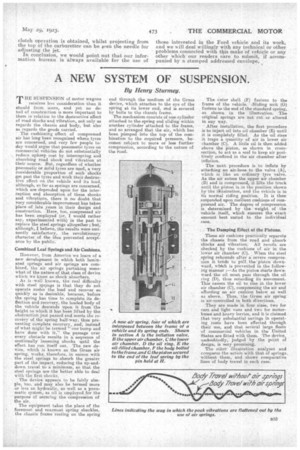A NEW SYSTEM OF SUSPENSION.
Page 21

If you've noticed an error in this article please click here to report it so we can fix it.
By Henry Sturmey.
rp HE SUSPENSION of motor wagons receives less consideration than it should from users, and yet no detail of construction is more important to them in "relation to the destructive effect of road shocks sad vibration, not only as regards the chassis and body, but also as regards the goods carried.
The cushioning effect. of compressed air has long been recognized where tyres are concerned, and very few people today would argue that pneumatic tyres on commercial vehicles do not substantially reduce upkeep cost by intercepting and absorbing road shock and vibration at their source. But-, regardless of whether pneumatic or solid tyres are used, a very considerable proportion of such shocks get past the tyres and work their destructive effect on the vehicle and its load, although, so far as springs are concerned, which are depended upon for the interception and absorption of these shocks and vibrations, there is no doubt that very considerable improvement has taken place of late years in their design and construction. Here, too, compressed air has been employed (or, I would rather say, experimented with) in the past to replace the steel springs altogether ; but, although, I believe, the results were eminently satisfactory, the revolutionary character of the idea prevented acceptance by the public.
Combined Leaf Springs and Air Cushions.
However, from America we learn of a new development in which both laminated springs and air springs are combined, the air springs partaking somewhat of the nature of that, class of device which we know as shock absorbers.
As is •well known, the real difficulty with steel spr,ings is that they do not operate under the, load and recover so quickly as is desirable, because, before the spring has time to complete its deflection and recovery, the loaded body of the vehicle descends upon it from the height to which it has been lifted by the obstructiott just passed and meets the recovery of the spring half-way, thus preventing complete recovery, and, instead of what might be termed one bump and have done with it." the passage over every obstacle results in .a sequence of continually lessening shocks until the effect, has run itself out. The new device, which is known as the Gruss air spring, works, therefore, in unison with the -steel springs to absorb the greater part of the. impact, reducing the up-anddown travel to a minimum, so that the steel springs are the better able to deal with the first shocks.
The device appears to he fairly simple, too, and may also be termed more or less an hydraulic, as well as a pneumatic system, as oil is employed,for the purpose of securing the compression of the air.
The equipment takes the place of the foremast and rearmost spring shackles, the chassis frame resting on the spring end through the medium of the Gruss device, which attaches to the eye of the spring at its lower end, and is secured by bolts to the chassis frame.
The mechanism consists of one cylinder attaolied to the spring end sliding within another cylinder attached to the frame, and so arranged that the air, which has been pumped into the top of the combination to the required pressure, becomes subject to more or less further compression, according to the nature of the road. The outer shell_ (F) fastens to the frame of the vehicle. Sliding unit (G) fastens to the end of the standard spring, as shown in the illustration. The original springs are not cut or altered in any way.
• After installation, the first procedure is to inject oil into oil chamber (E) until it is completely filled. As the oil rises it traps a quantity of air in lower air chamber (C). A little oil is then added above the -Piston, as shown in crosssection, to act as a seal to keep air positively confined in the air chamber after inflation.
The next procedure is to inflate by attaching an air-hose to the valve (A), which is like an ordinary tyre valve. As the air enters the upper air chamber (B) and is compressed, it. lifts the truck until the piston is in the position -shown by-the illustration, and the vehicle is in its normal riding position. It is then suspended upon resilient cushions of compressed air. The degree of compression is determined by the weight of the vehicle itself, which ensures the exact amount best suited to the individual ease, The Damping Effect of the Pistons.
These air cushions practically separate the chassis from the road and absorb shocks and vibration. All recoils are checked by the cushions of air in the lowee air chamber (C). When the steel spring rebounds after asevere compression it, tends to pull the piston downward, ivIrich is prevented in the following manner :—As the piston starts dews.Ward the oil must pass through the oil ring (D), thus retaxdiag its movement. This causes the oil to. rise in the lower air chamber (C), compressing the air and affording an air cushion below as well as above. Thus, the Grum air spring is air-controlled in both directions.
They are made in four sizes, two for cars and light vans and two for motorbuses and heavy lorries, and it, is claimed that very substantial savings in operating costs have been effected through their use, and that several large fleets of commercial vehicles in the United States are fitted with them. The device, undoubtedly, judged by the point of design, is very promising.
The other illustration analyses and compares theactiort with that of springs without them, and shows comparative lines of body travel in each case.
































